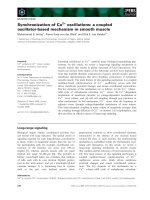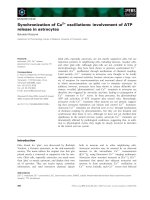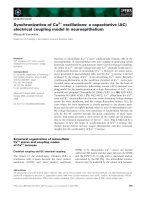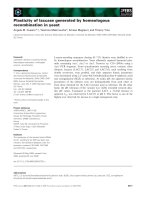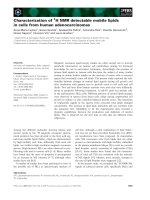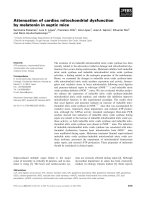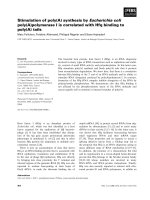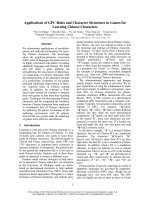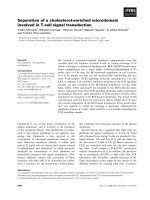Báo cáo khoa học: Role of Ca2+/calmodulin regulated signaling pathways in chemoattractant induced neutrophil effector functions Comparison with the role of phosphotidylinositol-3 kinase ppt
Bạn đang xem bản rút gọn của tài liệu. Xem và tải ngay bản đầy đủ của tài liệu tại đây (291.01 KB, 10 trang )
Role of Ca
2+
/calmodulin regulated signaling pathways
in chemoattractant induced neutrophil effector functions
Comparison with the role of phosphotidylinositol-3 kinase
Sandra Verploegen, Caroline M. van Leeuwen, Hanneke W. M. van Deutekom, Jan-Willem J. Lammers,
Leo Koenderman and Paul J. Coffer
Department of Pulmonary Diseases, University Medical Center Utrecht, the Netherlands
In human neutrophils, both changes in intracellular Ca
2+
concentrations, [Ca
2+
]
i
, and activation of phosphatidyl-
inositol-3 kinase (PtdIns3K) have been proposed to play a
role in regulating cellular function induced by chemoattr-
actants. In this study we have investigated the role of [Ca
2+
]
i
and its effector molecule calmodulin in human neutrophils.
Increased [Ca
2+
]
i
alone was sufficient to induce phospho-
rylation of extracellular signal-regulated protein kinase 2
(ERK2), p38 mitogen activated kinase (p38 MAPK), pro-
tein kinase B (PKB) and glycogen synthase kinase-3a
(GSK-3a). Inhibition of calmodulin using a calmodulin
antagonist N-(6-aminohexyl)-5-chloro-1-naphthalenesulfo-
namide (W7), did not effect N-formyl-methionyl-leucyl-
phenylalanine (fMLP) induced ERK, p38 MAPK or
GSK-3a phosphorylation, but attenuated fMLP induced
PKB phosphorylation. PCR analysis of human neutrophil
cDNA demonstrated variable expression of members of the
Ca
2+
/calmodulin-dependent kinase family. The roles of
calmodulin and PtdIns3K in regulating neutrophil effector
functions were further compared. Neutrophil migration was
abrogated by inhibition of calmodulin, while no effect was
observed when PtdIns3K was inhibited. In contrast, pro-
duction of reactive oxygen species was sensitive to inhibition
of both calmodulin and PtdIns3K. Finally, we demonstrated
that chemoattractants are unable to modulate neutrophil
survival, despite activation of PtdIns3K and elevation
[Ca
2+
]
i
. Taken together, our data indicate critical roles for
changes in [Ca
2+
]
i
and calmodulin activity in regulating
neutrophil migration and respiratory burst and suggest that
chemoattractant induced PKB phosphorylation may be
mediated by a Ca
2+
/calmodulin sensitive pathway in human
neutrophils.
Keywords:calmodulin;Ca
2+
PtdIns3K; neutrophil effector
functions; chemoattractants.
Neutrophils form a first line of host defense in the human
immune system as they are recruited to inflammatory sites
in response to infection or tissue injury. Here they phago-
cytose and kill invading pathogens [1–3]. One of the
responses of neutrophils to inflammatory mediators such
as chemoattractants, is the migration towards the site of
infection. This migration involves firm adhesion and
attachment to the endothelium, diapedesis and interaction
with extracellular matrix proteins [4]. Secondly, activated
neutrophils initiate the NADPH oxidase system, generating
reactive oxygen species (ROS), resulting in efficient killing of
pathogens [5]. For resolution of inflammation, removal of
neutrophils by programmed cell death is essential to avoid
tissue damage, which can be caused by excessive release of
granule proteases or inappropriate production of ROS [6].
Chemoattractants are potent activators of neutrophil
effector functions. In neutrophils they stimulate G-protein
coupled receptors, which in turn activate the trimeric
G-proteins. Exchange of GDP with GTP bound to the
Ga subunit, results in dissociation of the Gbc heterodimer,
which subsquently leads to the activation of phospholi-
pase Cb (PLCb)2 and PLCb3, resulting in hydrolysis of
PtdIns(4,5)P
2
into diacylglycerol and InsP
3
[7,8]. The
dissociation of the Gbc subunit can also result in activation
of phosphatidylinositol 3-kinase gamma (PtdIns3Kc) [9,10].
However it has also been reported that chemoattractant
induced G-protein-coupled receptor stimulation can also
activate the p85-associated class 1A PtdIns3K, through an
as yet undefined mechanism [11,12].
Both PLCb and PtdIns3Ks have been reported to be
important in mediating chemoattractant induced activation
of neutrophil effector functions [7,8,10,11,13,14]. Upon
neutrophil activation, PtdIns3K is recruited to the mem-
brane where it can phosphorylate phosphoinositides at the
D-3 position of the inositol ring. These phosphorylated
lipids, preferentially PtdIns(3,4)P
2
and PtdIns(3,4,5)P
3
,act
as second messengers forming docking sites for molecules
that posses a plextrin homology domain such as protein
kinase B (PKB) [15–17]. As previously mentioned, PLCb
Correspondence to P. J. Coffer, University Medical Center Utrecht,
Department of Pulmonary Diseases, G03550, Heidelberglaan 100,
3584 CX Utrecht, the Netherlands.
Fax: + 31 30 2505414, Phone: + 31 30 2507134,
E-mail: P.Coff
Abbreviations: PtdIns3K, phosphatidylinositol-3 kinase; ERK2,
extracellular signal-regulated protein kinase 2; p38 MAPK,
p38 mitogen activated kinase; PKB, protein kinase B; GSK-3a,
glycogen synthase kinase-3a;W7,N-(6-aminohexyl)-5-chloro-1-
naphthalenesulfonamide; fMLP, N-formyl-methionyl-leucyl-phenyl-
alanine; CaMK, Ca
2+
/calmodulin-dependent kinase; ROS, reactive
oxygen species; GM-CSF, granulocyte macrophage-colony
stimulating factor.
(Received 1 May 2002, revised 12 July 2002, accepted 1 August 2002)
Eur. J. Biochem. 269, 4625–4634 (2002) Ó FEBS 2002 doi:10.1046/j.1432-1033.2002.03162.x
hydrolyses PtdIns(4,5)P
2
into diacylglycerol and InsP
3
.
InsP
3
initiates the release of Ca
2+
from the endoplasmatic
reticulum, resulting in a rise in cytoplasmic Ca
2+
. Although
there have been several suggested functions for this rise of
the intracellular Ca
2+
concentration, [Ca
2+
]
i
, a clear role
for elevated [Ca
2+
]
i
in neutrophil function has not been
resolved [18,19]. An important downstream regulator of
Ca
2+
is the ubiquitously expressed protein calmodulin [20].
Calmodulin is activated by binding of four Ca
2+
ions,
resulting in conformational change. Once calmodulin is
activated it can bind to downstream targets, such as the
Ca
2+
/calmodulin-dependent kinases (CaMKs) [21,22].
CaMKs form a family of serine/threonine kinases activated
by binding of Ca
2+
/calmodulin and includes, CaMKI,
CaMKII, CaMKIV, CKLiK and CaMKK. Until now
there has been no evidence for a specific role of these kinases
in human granulocytes. However, recently we have
demonstrated that CKLiK mRNA is highly specifically
expressed in human neutrophils [23].
Stimulation of human neutrophils with chemoattractant
also regulates the activation of various intracellular protein
kinases. Downstream signal molecules such as extracellular
regulated kinase (ERK), PKB and the 38 kDa mitogen
activated protein kinase (p38 MAPK) have also been
implicated in the regulation of neutrophil effector functions
[11,24,25]. However, it is unclear whether the activation of
these signaling molecules might be mediated by either
activation of PtdIns3K or by a rise in [Ca
2+
]
i
, or by both.
Here we show that that elevated [Ca
2+
]
i
induces phos-
phorylation of downstream signaling molecules in a manner
similar to chemoattractants. Inhibition of calmodulin resul-
ted in a diminished PKB phosphorylation, but had no effect
on ERK, p38 MAPK and GSK-3a phosphorylation.
G-protein-coupled receptor mediated migration of human
neutrophils was found to be dependent on calmodulin
activity, but not on PtdIns3K. However, fMLP induced
respiratory bursts demonstrated a dependence on both
calmodulin and PtdIns3K activity. These data demonstrate
critical roles for changes in [Ca
2+
]
i
and calmodulin regulated
signaling pathways in chemoattractant induced neutrophil
effector functions such as migration and formation of ROS.
MATERIALS AND METHODS
Reagents and antibodies
Platelet-activating factor, fMLP (N-formyl-methionyl-leu-
cyl-phenylalanine), cytochrome c and N-(6-aminohexyl)-5-
chloro-1-naphtalenesulfonamide (W7) were purchased from
Sigma. Recombinant human granulocyte macrophage-
colony stimulating factor (GM-CSF) was obtained from
Genzyme (Boston, MA, USA). Ionomycin was puchased
from Calbiochem (La Lolla, CA, USA) and human IL-8
from PrepoTech (Rocky Hill, NJ, USA). LY294002 was
purchased from Biomol (Plymouth Meeting, PA, USA).
Polyclonal anti-[phospho-p42/44 MAPK (Thr202/Tyr204)],
anti-[phospho-p38 MAPK (Thr180/Thr182)], anti-[phos-
pho-PKB (Ser473)], anti-[phospho-PKB (Thr308)] and
anti-[phospho-GSK-3a/b(Ser9/Ser21)] Ig were obtained
from Cell Signaling (Beverly, MA, USA). Anti-ERK2 (C-
14), anti-actin (I-19) and anti-(p38 MAPK) (C20) Ig were
purchased from Santa Cruz Biotechnology Inc. (Santa Cruz,
CA).
Isolation of human neutrophils
Blood was obtained from healthy volunteers at the donor
service of the University Medical Center anticoagulated
with 0.4% (w/v) trisodium citrate (pH 7.4). Neutrophils
were isolated as follows. Mononuclear cells were depleted
from neutrophils by centrifugation over isotonic Ficoll from
Pharmacia (Uppsula, Sweden). After lysis of the erythro-
cytesinanisotonicNH
4
Cl solution, neutrophils were
washed and resuspended in incubation buffer (20 m
M
Hepes, 132 m
M
NaCl, 6 m
M
KCl, 1 m
M
MgSO
4
,1.2m
M
KH
2
PO
4
,5m
M
glucose, 1 m
M
CaCl
2
and 0.5% human
serum albumin). Neutrophils were incubated for 30 min at
37 °C before experiments were performed.
RNA isolation, cDNA synthesis and PCR
mRNA was isolated from neutrophils by lysing cells
(2.5 · 10
7
)in400lL solution containing 4
M
guanidine-
isothiocyanate, 25 m
M
sodium citrate, 1 m
M
2-mercapto-
ethanol, 0.5% sarkosyl and 0.1% antifoaming agent. RNAs
were further isolated by phenol extraction and ethanol
precipitation. To remove possible DNA contamination, the
RNA solution was treated with DNAse I (Clontech
Laboratories, Palo Alto, CA, USA) for 30 min at 37 °C
and RT-PCR was performed with of purified RNA (1 lg).
A 25-lL PCR was performed using 0.1 lL of cDNA,
12.5 lL of SYBR Green PCR master mix containing
6-carboxy rhodamine (ROX) as a passive reference (PE
Applied Biosystems, Nieuwerkerk a/d ijssel, the Nether-
lands) and 400 n
M
of each primer. For b-actin, a 174-bp
fragment was amplified using the forward primer 5¢-
AGCCTCGCCTTTGCCGA-3¢ and the reverse primer 5¢-
CTGGTGCCTGGGGCG-3¢ as described by Kreuzer
et al. [27]. For the CaMK family members following
primers were used: CaMKI forward: 5¢-CGGAGGACA
TTAGAGACA-3¢,reverse:5¢-CTCGTCATAGAAGGG
AGG-3¢;CaMKIIforward:5¢-GGTTCACGGACGAGT
ATC-3¢,reverse:5¢-TGGCATCAGCTTCACTGTA-3¢;
CaMKIV forward: 5¢-GATGAAAGAGGCGATCAG-3¢,
reverse: 5¢-TAGGCCCTCCTCTAGTTC-3¢;CKLiKfor-
ward: 5¢-GGCAAAGGAGATGTGATG-3¢, reverse:
5¢-CTGCTCGAAACACTTGC-3¢ and CaMKK forward:
5¢-TCTCCATCACGGG-TATGC-3¢ and reverse:
5¢-GCGTCACTGCCCTTGAAT-3¢. Amplification and
detection were performed with an ABI Prism 7700 sequence
detection system (PE Applied Biosystems, Nieuwerkerk a/d
ijssel, the Netherlands) under the following conditions:
2minat50°C, 10 min at 95 °C to activate AmpliTaq Gold
DNA polymerase, and 40 cycles of 15 s at 95 °Cand1min
at 60 °C. During amplification, the ABI Prism sequence
detector monitored real-time PCR amplification by quan-
titatively analyzing fluorescence emissions. The signal of
SYBR green I dye was measured against the internal
reference dye signal to normalize for non-PCR-related
fluorescence fluctuations occurring from well to well.
Results were normalized for the housekeeping gene b-actin.
Cell lysates, Western blotting and kinase assay
Neutrophils were stimulated with fMLP (1 l
M
)IL-8
(10
)8
M
) or ionomycin (1 l
M
) for several time points and
pretreated if necessary with 5–50 l
M
W7 for 20 min at 37 °C.
4626 S. Verploegen et al. (Eur. J. Biochem. 269) Ó FEBS 2002
For Western blotting with anti-(phospho-ERK) or anti-
(phospho-p38 MAPK) Ig, cells (10
6
) were lysed in 40 lL
sample buffer (60 m
M
Tris/HCl pH 6.8, 2% SDS, 10%
glycerol and 2% 2-mercaptoethanol) and boiled for 5 min at
95 °C. For Western blotting with anti-(phospho-PKB)
or anti-(phospho-GSK-3a) Ig, cells (4 · 10
6
) were lysed in
40 lL lysis buffer (50 m
M
Tris/HCl pH 8, 100 m
M
NaCl,
5m
M
EDTA, 1% Triton X100, 1 m
M
Na
3
VO
4
,10 lgÆmL
)1
aprotinin, 10 lgÆmL
)1
leupeptin, 1 m
M
benzamidin, 1 m
M
phenylmethanesulfonyl fluoride and 1 m
M
di-isopropyl
fluorophosphate). Lysates were centrifuged at 4 °Cfor
5minand5· sample buffer was added to the supernatant
before boiling the samples. For PKB kinase assays, neu-
trophils were lysed and PKB was immune precipitated with
anti-PKB. The kinase assay was performed as previously
described [28].
Analysis of neutrophil migration
Video microscopy and tracking of neutrophils was per-
formed as described previously [29]. In short, glass
coverslips were coated with Hepes buffer containing
0,5% human serum albumin (20 m
M
Hepes, 132 m
M
NaCl, 6 m
M
KCl, 1 m
M
MgSO
4
,1.2m
M
KH
2
PO
4
,5m
M
glucose, 1 m
M
CaCl
2
). Purified neutrophils (10
6
mL
)1
in
Hepes buffer) were first incubated at 37 °C for 20 min and
pretreated with W7 (50 l
M
) or LY294002 (20 l
M
)for
10 min. Neutrophils were allowed to attach to the coverslip
for 10–15 min at 37 °C. Medium was removed and the cells
were washed twice with Hepes buffer. The coverslip was
then inverted in a droplet of medium containing 10
)8
M
IL-
8 and sealed with a mixture of beeswax, paraffin, and
petroleum jelly (1 : 1 : 1, w/w/w). Cell tracking at 37 °C
was monitored by time–lapse microscopy and analyzed by
custom-made macro (Arithmetic Language for Images;
ALI) in image analysis software (
OPTIMAS
6.2; Media
Cybernetics, Silver Spring, MD, USA). Cell migration was
followed for 10 min making a picture every 20 s. Boyden
chamber assays were performed as described previously
[30]. Cellulose nitrate filters (pore width 8 lm, thickness
150 lm; Sartorius) were soaked in 0.5% human serum
albumin. The assay was performed in Hepes buffer
supplemented with 0.5% human serum albumin for 1.5 h
at 37 °CinaCO
2
incubator. Filters were fixed, stained
with hematoxilin and imbedded in malinol. Analysis of the
filters was performed by an image analysis system (Quan-
timet 570C) and an automated microscope to score the
number of cells at 15 intervals of 10 lm in the Z-direction
of the filters. The results are expressed as the chemotactic
index, indicating the mean migrated distance, excluding
cells with migration 0.
Measurement of ROS production
Respiratory burst was measured by ROS induced cyto-
chrome c reduction [31]. Assay was performed as previously
described [32]. Neutrophils (4 · 10
6
cellsÆmL
)1
)wereprein-
cubated with W7 (20 or 50 l
M
) or LY294002 (20 l
M
)for
20 min and GM-CSF (10
)10
M
) to prime the cells. Cyto-
chrome c (75 l
M
)wasaddedandtransferredtoamicrotitre
plate and placed in a thermostat-controlled plate reader (340
ATTC; SLT Laboratory Instruments, Salzburg, Austria).
ROS production was induced by stimulation with 1 l
M
fMLP. Cytochrome c reduction was immediately measured
every 12 s as an increase in absorbance at 550 nm.
Measurement of apoptosis
Apoptosis was measured by analyzing annexin V-fluores-
cein isothiocyanate-binding (Bender Medsystems; Vienna,
Austria). In short, neutrophils were resuspended in Hepes
buffered RPMI containing 8% serum (Hyclone) at a
concentration of 10
6
mL
)1
and treated with GM-CSF
(10
)10
M
)orIL-8(10
)7
M
) and incubated at 37 °Cfor
indicated time periods. Cells were stored at 4 °C until last
incubation timepoint had been reached. Cells were washed
and resuspended in binding buffer (10 m
M
Hepes/NaOH
pH 7.4, 140 m
M
NaCl, 2.5 m
M
CaCl
2
). Subsequently cells
were incubated with annexin V-fluorescein isothiocyanate
for 15 min at room temperature in the dark, washed and
resuspended in binding buffer. Propidium iodide was added
(1 lgÆmL
)1
) and the percentage of apoptotic cells, was
detected by FACS analysis (FACSvantage, Becton Dickin-
son).
RESULTS
Comparison of intracellular signaling pathways
activated by chemoattractants and elevated [Ca
2+
]
i
Stimulation of human neutrophils with chemoattractants
has been reported to result in the activation of several
intracellular signaling pathways. It is of were interest to
determine whether changes in [Ca
2+
]
i
alone could modulate
these responses. To this end, we analyzed if activation of
several kinases could be induced by addition of the Ca
2+
ionophore ionomycin, or the chemoattractant fMLP. The
phosphorylation state of ERK1/2, p38 MAPK, PKB and
GSK-3a after stimulation of neutrophils with ionomycin or
the chemoattractant fMLP was compared. Addition of
fMLP resulted in a rapid phosphorylation of ERK2 and
p38 MAPK, being optimal at 1 min after stimulation
(Fig. 1A, left panel). Elevation of [Ca
2+
]
i
, by ionomycin
addition, was also sufficient to induce ERK2 phosphoryla-
tion (Fig. 1B, upper left panel). This was optimal after 30 s
and was maintained for at least 15–30 min. Similarly,
ionomycin also induced rapid phosphorylation of
p38 MAPK (Fig. 1A, lower left panel).
PtdIns3K activation results in the recruitment of PKB to
the membrane where kinases, such as PDK1, can phospho-
rylate and thereby activate PKB. Recently it has been
demonstrated that CaMKK phosphorylates PKB suggest-
ing a role for Ca
2+
in the activation of PKB [33]. Treatment
with ionomycin was sufficient to induce PKB phosphory-
lation in human neutrophils (Fig. 1A, upper right panel).
Additionally, GSK-3a adirecttargetofPKBmediated
phosphorylation, was also phosphorylated upon ionomycin
treatment (Fig. 1A, lower right panel). Both PKB and
GSK-3a phosphorylation after ionomycin treatment were
still elevated after 30 min. Taken together, these data show
that increased [Ca
2+
]
i
alone is sufficient to induce phos-
phorylation of ERK2, p38 MAPK, PKB and GSK-3a,
similar to receptor-mediated activation by chemoattrac-
tants.
Ó FEBS 2002 Role of Ca
2+
/calmodulin in human neutrophils (Eur. J. Biochem. 269) 4627
Calmodulin is critical for chemoattractant mediated
PKB phosphorylation in human neutrophils
Increased [Ca
2+
]
i
is sufficient to regulate multiple intracel-
lular signaling pathways. Therefore, the role of calmodulin,
the major downstream effector of Ca
2+
, in the regulation of
intracellular signaling was analyzed by using the inhibitor
W7. This inhibitor was found highly specific for calmodulin
[34], although the possiblity of nonspecific can never be
completely ruled out. ERK2 phosphorylation was only
partially inhibited at a concentration of 50 l
M
W7 (Fig. 2A,
upper panel) and no effect was observed on the regulation of
p38 MAPK when calmodulin was inhibited (Fig. 2A, lower
panel). A dramatic inhibition of fMLP induced PKB-
phosphorylation on both Ser473 phosphorylation and
Thr308 phosphorylation, was observed, when cells were
treated with W7 (Fig. 2B, upper panels). This resulted in an
inhibited PKB kinase activity as is demonstrated in Fig. 2C.
Surprisingly GSK-3a, which has been previously demon-
strated to be a downstream target of PKB in several cell
types, exhibited no sensitivity to W7 (Fig. 2B, lower panel).
In conclusion, these results demonstrate that chemoattrac-
tant mediated PKB activation, unlike that of ERK2 and
p38 MAPK, is dependent on calmodulin. Additionally,
these data suggest that fMLP induced GSK-3a phospho-
rylation in human neutrophils can occur in a PKB-
independent manner.
Expression of Ca
2+
/calmodulin-dependent kinases
in human neutrophils
Binding of Ca
2+
to calmodulin enables it to interact with
and activate CaMKs. Previous reports have demonstrated
that CaMKs can phosphorylate PKB, ERK and JNK
in vitro [23,33,35]. However, little is known about the
expression of kinases directly activated by changes in
[Ca
2+
]
i
in human neutrophils. In order to identify CaMKs
expressed in human neutrophils, real time PCR was
performed with neutrophil cDNA and specific CaM kinase
primers for CaMKI, CaMKII, CaMKIV, CKLiK and
CaMKK. Expression levels of the CaMK family members
compared to b-actin is depicted in Fig. 3. Highest expres-
sion was observed for CKLiK and CaMKK. Low amounts
of CaMKII and CaMKI were detected. While, no CaM-
KIV expression could be detected.
Chemoattractant mediated neutrophil migration
is abrogated by inhibition of calmodulin but not by
inhibition of PtdIns3K
In order to investigate the role of [Ca
2+
]
i
and calmodulin in
neutrophil function, two processes critical for host defense,
migration and the generation of ROS, were investigated.
During neutrophil migration, activation of PtdIns3K and
changes in [Ca
2+
]
i
occur as a results of chemoattractant
Fig. 1. Regulation of neutrophil signaling
pathways, by fMLP and ionomycin. Human
neutrophils were isolated and stimulated with
(A) 1 l
M
fMLP or (B) 1 l
M
ionomycin for
indicated time points. Cells were lysed and
Western blotting was performed as described
in Materials and methods. Phosphospecific
antibodies were used for ERK-P,
p38 MAPK-P, PKB-P and GSK3-P. The
levels of ERK2, p38 MAPK and actin were
determined as a control for equal loading of
proteins. Data are representative of three
independent experiments.
4628 S. Verploegen et al. (Eur. J. Biochem. 269) Ó FEBS 2002
induced G-protein-coupled receptor activation. Although a
specific role for [Ca
2+
]
i
in regulating migration has not been
defined, some aspects of the migration process have been
shown to be at least partially controlled by changes in
[Ca
2+
]
i
[36]. Analysis of the role of calmodulin and
PtdIns3K in IL-8 induced neutrophil migration on albumin
coated coverslips was performed. IL-8 is known to be a
potent activator of neutrophil migration, and activates the
G-protein-coupled receptors, CXCL1 and CXCL2, within
the same family of the fMLP receptor [37]. Migration of
neutrophils was measured in the presence of IL-8 for
10 min, and the effect of specific inhibitors of calmodulin
(W7) or PtdIns3K (LY294002), were analyzed by recording
migratory tracks (Fig. 4A, upper panels). To aid compar-
ison, the tracks are centered in Fig. 4A (lower panels). Upon
IL-8 stimulation, neutrophil migration was markedly
increased. Both the migration distance and the migration
speed are clearly elevated by IL-8 treatment from 1.68 ±
0.35 to 7.08 ± 1.33 lmÆmin
)1
(Fig. 4B). Pre-incubation
with W7 abrogated the IL-8 induced migration completely,
whereas inhibition of PtdIns3K with LY294002 showed no
effect on the IL-8 induced migration on albumin (see
Fig. 4A,B). Similar results were also observed for fMLP
induced migration (data not shown). Additionally, we
investigated the effect of the MEK inhibitor PD98089 in this
assay, however, no inhibitory effect was observed, suggest-
ing that MEK has no role in migration (data not shown).
Fig. 2. Effect of calmodulin inhibitor W7 on
protein phosphorylation in neutrophils after
fMLP stimulation. Isolated neutrophils were
incubated with DMSO (dimethylsulfoxide) or
increasing concentrations of W7 (5–50 l
M
)for
20 min before stimulation with 1 l
M
fMLP
for 1 min. Cells were lysed and phosphory-
lated proteins detected by Western blotting as
describedinMaterialsandmethods.(A)
ERK-P and p38 MAPK-P. (B) PKB-P
Ser473, PKB-P Thr308 and GSK3-P. The
levels of ERK2, p38 MAPK and actin were
determined as a control of equal loading. Data
arerepresentativeofatleastthreeindependent
experiments. (C) Neutrophils (10
7
) were incu-
batedwith50l
M
W7 and lysed. PKB kinase
assays were performed using histone 2B as a
substrate. Data are representative of two
independent experiments.
Fig. 3. Expression of Ca
2+
/calmodulin dependent kinases in neutro-
phils. cDNA was synthesized from neutrophil mRNA as described in
Materials and methods. Real time PCR with specific primers for
CaMKI, II, IV, CKLiK, CaMKK was performed. Expression levels of
the different CaMKs relative to b-actin are depicted. Data are repre-
sentative of three independent experiments.
Ó FEBS 2002 Role of Ca
2+
/calmodulin in human neutrophils (Eur. J. Biochem. 269) 4629
We further investigated the role of calmodulin and
PtdIns3K in boyden chamber migration assays and ob-
served similar results. W7 inhibited the IL-8-induced
migration of human neutrophils, while no effect was
observed with LY294002 (Fig. 4C). In addition, fMLP
induced migration demonstrated similar results (data not
shown). These results suggest that PtdIns3K is not necessary
for chemokine induced neutrophil migration, and demon-
strate a critical role for calmodulin, and thus changes in
[Ca
2+
]
i
, in IL-8 induced neutrophil migration on albumin
coated surfaces.
Both calmodulin and PtdIns3K are critical in generation
of ROS in human neutrophils
Stimulation of neutrophils with the chemoattractant fMLP
induces the rapid formation of ROS. This process, termed the
respiratory burst, is initiated by the association of the
intracellular multiprotein complex NADPH oxidase, which
catalyzes the production of ROS and results in efficient
killing of invading pathogens [5]. The effect of the calmodulin
inhibitor W7 on fMLP induced ROS production was
investigated and compared with the effect of the PtdIns3K
inhibitor LY294002. The respiratory burst is dependent on
prior priming of cells with cytokines, chemoattractants, or
lipopolysaccharides [1,38]. Neutrophils were therefore pre-
treated with GM-CSF. W7 or LY294002 were added 20 min
before stimulation with fMLP. As shown in Fig. 5, unprimed
cells were unable to activate the respiratory burst upon fMLP
stimulation. However, cells first primed with GM-CSF
induced a rapid production of ROS. Pre-treatment with W7
resulted in a concentration dependent inhibition of ROS
production, which was also observed with the PtdIns3K
inhibitor LY294002. These data indicate that both PtdIns3K
and calmodulin are necessary for optimal chemoattractant
mediated ROS production in human neutrophils.
Fig. 4. Effect of W7 and LY294002 on IL-8
induced neutrophil migration. Migration of
neutrophils was monitored by video micros-
copy. Cells were preincubated as indicated
with 50 l
M
W7 or 20 l
M
LY294002 for
10 min, followed by attachment to albumin
coated coverslips for 15 min. Neutrophil
migration was induced by 10
)8
M
IL-8 and
imaged every 20 s for 10 min (A, upper panels)
Tracks and image of cells are shown as
migration tracks of individual cells. (A, lower
panels) Centered tracks are depicted. (B)
Average migration speed of at least three
independent experiments are calculated and
expressed as lmÆmin
)1
± SD. (C) Neutro-
phils were treated with indicated concentra-
tions of LY294002 and W7 and assayed in
boyden chambers as described in Material and
methods. Data are representative for three
independent experiments.
Fig. 5. Comparison of the effect of W7 and LY294002 on the respiratory
burst in human neutrophils. Cells were isolated and treated without
(open symbol) and with 10
)10
M
GM-CSF (closed symbols) to prime
the cells. Before initiation of the respiratory burst with 1 l
M
fMLP,
cells were pretreated with DMSO (dimethylsulfoxide), 20 l
M
W7,
50 l
M
W7 or 20 l
M
LY294002 for 20 min as indicated. ROS pro-
duction was measured by cytochrome c reduction resulting in a change
in absorption at a wavelength of 550 nm. The average of three inde-
pendent experiments are depicted. DMSO, dimethylsulfoxide.
4630 S. Verploegen et al. (Eur. J. Biochem. 269) Ó FEBS 2002
Chemokines in contrast to cytokines play no role
in regulating neutrophil survival
Neutrophil apoptosis, and recognition and removal of cells
by macrophages is an essential event in the termination of
inflammation and prevention of damage to host tissue.
Neutrophils are intrinsically committed to programmed
cell death, however, inflammatory cytokines such as
GM-CSF can delay this process [32,39,40]. Furthermore,
there are some indications that other inflammatory
mediators may be able to inhibit neutrophil apoptosis
[41]. In this study, we wished to determine whether
chemoattractants could protect human neutrophils from
apoptosis. One of the early events during apoptosis is the
appearance of phosphatidylserine on the extracellular
surface of cells. Phosphatidylserine can bind to (fluorescein
isothiocyanate-labeled) annexin V and can function as a
marker of programmed cell death (Fig. 6A). After 16 h,
78% of all neutrophils were annexin V positive. Relative
to this level of apoptotic cells (average of individual
experiments, considered to be 100% in Fig. 6B), 35% of
these cells were rescued from apoptosis after treatment
with GM-CSF. IL-8 treated cells, however, showed no
additional survival compared with the untreated neu-
trophils. We hypothesized that IL-8 might show an
additional effect to GM-CSF in the delay of apoptosis,
but no additional effect was observed when neutrophils
were treated with both GM-CSF and IL-8 (Fig. 6A,B).
Therefore chemoattractant induced activation of PtdIns3K
and elevation of [Ca
2+
]
i
are in themselves insufficient in
the protection of neutrophils against apoptosis.
DISCUSSION
In this study, the role of Ca
2+
and its downstream effector
calmodulin in G-protein-coupled receptor regulated signal-
ing pathways in human neutrophils was investigated.
Additionally, the role of calmodulin and PtdIns3K in
chemoattractant induced neutrophil effector functions, such
as migration and respiratory burst, were compared. Treat-
ment of cells with the calcium ionophore ionomycin,
resulted in the phosphorylation of ERK2, p38 MAPK,
PKB and GSK-3a (Fig. 1). This demonstrates that
increased [Ca
2+
]
i
is itself sufficient to activate these kinases
and suggests that the elevated [Ca
2+
]
i
generated by chemo-
attractants might be important in activation of downstream
signaling events. Compared to fMLP treatment, ionomycin
illustrated a prolonged phosphorylation of ERK2, PKB
Fig. 6. Comparison of the effects of cytokines
and chemokines on neutrophil survival. Isolated
neutrophils were preincubated at 37 °Cin
Hepes buffered RPMI containing 8% serum.
Cellsweretreatedfor16hwithindicated
10
)10
M
GM-CSF or/and 10
)7
M
IL-8 or a
combination. (A) The percentage of apoptotic
cells was analyzed by annexin V-fluorescein
isothiocyanate and propidium iodide staining.
FACS Dotplots of 0 and 16 h are depicted
and percentage of annexin V or propidium
iodide positive cells are displayed. (B) The
average of percentage annexin V positive cells,
of at least four independent experiments are
depicted and error bars (SD) are indicated.
The total fraction of apoptotic cells at 16 h in
untreated conditions was corrected to 100%.
Ó FEBS 2002 Role of Ca
2+
/calmodulin in human neutrophils (Eur. J. Biochem. 269) 4631
and GSK-3a in these cells. This might be due to the
continuously elevated [Ca
2+
]
i
induced by ionomycin, or it
may indicate that elevation of [Ca
2+
]
i
alone is not sufficient
to activate inhibitory signaling pathways normally respon-
sible for ERK, PKB and GSK-3a dephosphorylation.
Analysis of the effect of calmodulin inhibition on
signaling pathways induced by chemoattractants in human
neutrophils showed a minor inhibition of ERK phosphory-
lation and a dramatic inhibition of PKB phosphorylation
(Fig. 2). Although there are some indications that CaMKIV
and CKLiK may influence ERK activation in vivo [23,35],
our data suggests that calmodulin is at least not essential in
G-protein-coupled receptor regulated ERK activity.
Importantly, we demonstrated that W7 inhibited PKB
phosphorylation on both Ser473 and Thr308 (Fig. 2B). In
general, generation of PtdInsP
3
by PtdIns3K initiates
recruitment of PKB though its plexstrin homology domain
to the membrane. For activation of PKB, phosphorylation
on Ser473 and Thr308 are necessary and additional kinases
are involved. Indeed, we demonstrate that fMLP induced
PKB activation was inhibited by W7 (Fig. 2C). It has been
reported that CaMKK can phosphorylate PKB directly
[33]. These data, together with our RT-PCR expression
data, suggest that CaMKK could play an important role in
PKB activation in human neutrophils stimulated by
chemoattractants. Whether CaMKK is recruited to the
membrane or can activate PKB cytosolically in human
neutrophils still has to be elucidated. Interestingly, GSK-3a,
which has previously been shown to be a downstream target
of PKB in several cell types, exhibited no sensitivity to
calmodulin inhibition. Because we observed complete
inhibition of PKB phosphorylation it appears that PKB
activation is not necessary for chemoattractant induced
GSK-3a phosphorylation in human neutrophils. GSK-3a
phosphorylation has been reported to be mediated by
protein kinases other then PKB. For example growth
factors can inhibit GSK-3a activity by means of the classical
MAPK pathway [42]. There are also indications that
phosphorylation of GSK-3a can be mediated by protein
kinase A or by a pathway that involves the mammalian
target of rapamycin [43,44]. In guinea pig neutrophils it has
been demonstrated that GSK-3a phosphorylation could
only be inhibited by dual treatment of the PtdIns3K
inhibitor wortmannin and the MEK inhibitor PD98059
[45]. Furthermore, our data illustrate that fMLP induced
GSK-3a phosphorylation is more sustained relative to PKB
phosphorylation, and the kinetics are rather similar to that
fMLP induced ERK phosphorylation (see Fig. 1).
We demonstrate an inhibition of neutrophil migration
by W7 (Fig. 4). A calmodulin-dependent kinase that might
be involved in this process is myosin light chain kinase.
This kinase phosphorylates the light chain of myosin II,
which is thought to be important for contraction at the
rear of the cell [46]. Furthermore, Ca
2+
is suggested to
play a role in the recycling of integrins, which are involved
in cell adhesion and attachment [47]. Additionally, it has
been described that CaMKII counteracts the calcineurin
induced affinity switch of a
5
b
1
integrin in CHO cells,
suggesting also a role for Ca
2+
/calmodulin-dependent
molecules in regulating the affinity state of integrins on
neutrophils [48].
Although PtdIns3K has been suggested to play a role
in signaling to the actin cytoskeleton [9], no inhibitory
effect of LY294002 on chemoattractant induced migra-
tion was observed. Neither neutrophil migration on
albumin coated glass coverslips nor migration in boyden
chambers were not inhibited by LY29004 treatment,
suggesting a minor role for PtdIns3K in chemoattractant
induced migration. We have demonstrated previously that
fMLP induced migration is insensitive to inhibition of
PtdIns3K by wortmannin [11]; the high concentration of
LY294002 used in our assay was also unable to inhibit
migration (data not shown). Although contradictory
findings have been reported [14,49], our data do not
support a role for PtdIns3K in chemokine induced
neutrophils migration.
We also demonstrate that fMLP induced ROS produc-
tion was dependent on both, calmodulin and PtdIns3K. In
guinea pig neutrophils, it has been demonstrated that
inhibition of calmodulin results in inhibition of Rac and p21
activated kinases [50]. Involvement of Rac in ROS produc-
tion has been demonstrated [5] and a role for the p21
activated kinase has been suggested in phosphorylation of
the 67 kDa subunit of the NADPH complex [51]. However,
in human neutrophils we have shown that Rac activation
was independent of changes in [Ca
2+
]
i
[52]. A role for PKB
has been suggested in phosphorylation the 47 kDa subunit
of the NADPH complex, p47
phox
, because membrane
targeted PtdIns3K leads to PKB phosphorylation and
p47
phox
phosphorylation [53]. Recently a role for PtdIns3K
in the respiratory burst has been shown, since it has been
demonstrated that the Phox homology domains in p47
phox
and p40
phox
bind to different phosphorylated PtdIns
molecules [54,55]. Although direct activation of components
in the multiprotein complex by PKB has not been shown, it
is possible that the inhibitory effect of W7 on the generation
of ROS will be mediated by PKB.
As demonstrated in Fig. 6, neutrophil apoptosis was
unaffected by chemokine stimulation. In a previous report
we have demonstrated a role for the PtdIns3K-PKB
pathway in cytokine mediated delay of apoptosis in
human neutrophils [32]. Although IL-8 induces activation
of PtdIns3K and PKB and increases [Ca
2+
]
i
, our results
demonstrate that it does not affect neutrophil survival.
The divergent effects on apoptosis from cytokines and
chemokines might be due to the difference in kinetics.
Chemokines transduce rapid signaling events, while cyto-
kine signaling is relatively slow. Furthermore, no addi-
tional effect on GM-CSF delayed apoptosis by IL-8 could
be observed. It has been suggested that Ca
2+
induced
PKB phosphorylation might lead to survival [33]. How-
ever, here we demonstrate that there is no role for
chemoattractants and thus [Ca
2+
]
i
in regulating neutrophil
apoptosis.
Taken together, we have demonstrated that elevations of
[Ca
2+
]
i
and calmodulin play central roles in chemoattrac-
tant induced neutrophil effector functions, such as migra-
tion and respiratory burst, which partially overlap with
PtdIns3K regulated functions. A possible convergence of
PtdIns3K and Ca
2+
/calmodulin regulated pathways might
be at the level of PKB activation, in which PtdIns3K recruits
PKB to the plasma membrane and calmodulin-regulated
kinases mediate its phosphorylation. Further work is
necessary to determine precisely which CaMKs are import-
ant in the Ca
2+
/calmodulin mediated effector functions of
human neutrophils.
4632 S. Verploegen et al. (Eur. J. Biochem. 269) Ó FEBS 2002
REFERENCES
1. Haslett, C., Savill, J.S. & Meagher, L. (1989) The neutrophil. Curr.
Opin. Immunol. 2, 10–18.
2. Mollinedo, F., Borregaard, N. & Boxer, L.A. (1999) Novel trends
in neutrophil structure, function and development. Immunol.
Today 20, 535–537.
3. Williams, M.A. & Solomkin, J.S. (1999) Integrin-mediated sig-
naling in human neutrophil functioning. J. Leukoc. Biol. 65, 725–
736.
4. Springer, T.A. (1990) Adhesion receptors of the immune system.
Nature 346, 425–434.
5. DeLeo, F.R. & Quinn, M.T. (1996) Assembly of the phagocyte
NADPH oxidase: molecular interaction of oxidase proteins.
J. Leukoc Biol. 60, 677–691.
6. Akgul, C., Moulding, D.A. & Edwards, S.W. (2001) Molecular
control of neutrophil apoptosis. FEBS Lett. 487, 318–322.
7. Wu, D., LaRosa, G.J. & Simon, M.I. (1993) G protein-coupled
signal transduction pathways for interleukin-8. Science 261, 101–
103.
8. Li, Z., Jiang, H., Xie, W., Zhang, Z., Smrcka, A.V. & Wu, D.
(2000) Roles of PLC-beta2 and -beta3 and PI3Kgamma in che-
moattractant-mediated signal transduction. Science 287, 1046–
1049.
9. Rickert, P., Weiner, O.D., Wang, F., Bourne, H.R. & Servant, G.
(2000) Leukocytes navigate by compass: roles of PI3Kgamma and
its lipid products. Trends Cell Biol. 10, 466–473.
10. Wu, D., Huang, C.K. & Jiang, H. (2000) Roles of phospholipid
signaling in chemoattractant-induced responses. J.CellSci.113,
2935–2940.
11. Coffer,P.J.,Geijsen,N.,M’rabet,L.,Schweizer,R.C.,Maikoe,T.,
Raaijmakers, J.A., Lammers, J.W. & Koenderman, L. (1998)
Comparison of the roles of mitogen-activated protein kinase
kinase and phosphatidylinositol 3-kinase signal transduction in
neutrophil effector function. Biochem. J. 329, 121–130.
12. Okada, T., Hazeki, O., Ui, M. & Katada, T. (1996) Synergistic
activation of PtdIns 3-kinase by tyrosine-phosphorylated peptide
and beta gamma-subunits of GTP-binding proteins. Biochem. J.
317, 475–480.
13. Hirsch, E., Katanaev, V.L., Garlanda, C., Azzolino, O., Pirola, L.,
Silengo, L., Sozzani, S., Mantovani, A., Altruda, F. & Wymann,
M.P. (2000) Central role for G protein-coupled phosphoinositide
3-kinase gamma in inflammation. Science 287, 1049–1053.
14. Sasaki, T., Irie-Sasaki, J., Jones, R.G.A.J., Stanford, W.L., Bolon,
B., Wakeham, A., Itie, A., Bouchard, D., Kozieradzki, I., Joza,
N., Mak, T.W., Ohashi, P.S., Suzuki, A. & Penninger, J.M. (2000)
Function of PI3Kgamma in thymocyte development, T cell acti-
vation, and neutrophil migration. Science 287, 1040–1046.
15. Toker, A. & Cantley, L.C. (1997) Signalling through the lipid
products of phosphoinositide-3-OH kinase. Nature 387, 673–676.
16. Shaw, G. (1996) The pleckstrin homology domain: an intriguing
multifunctional protein module. Bioessays 18, 35–46.
17. Coffer, P.J., Jin, J. & Woodgett, J.R. (1998) Protein kinase B
(c-Akt): a multifunctional mediator of phosphatidylinositol
3-kinase activation. Biochem. J. 335, 1–13.
18. Davies, E.V. & Hallett, M.B. (1998) Cytosolic Ca
2+
signalling in
inflammatory neutrophils: implications for rheumatoid arthritis.
Int. J.Mol. Med. 1, 485–490.
19. Mandeville, J.T. & Maxfield, F.R. (1996) Calcium and signal
transduction in granulocytes. Curr. Opin. Hematol. 3, 63–70.
20. Chin, D. & Means, A.R. (2000) Calmodulin: a prototypical cal-
cium sensor. Trends Cell Biol. 10, 322–328.
21. Soderling, T.R. (1999) The Ca-calmodulin-dependent protein
kinase cascade. Trends Biochem. Sci. 24, 232–236.
22. Hook, S.S. & Means, A.R. (2001) Ca(2+)/CaM-dependent kin-
ases: from activation to function. Annu. Rev. Pharmacol. Toxicol.
41, 471–505.
23. Verploegen, S., Lammers, J.W., Koenderman, L. & Coffer, P.J.
(2000) Identification and characterization of CKLiK, a novel
granulocyte Ca(++)/calmodulin-dependent kinase. Blood 96,
3215–3223.
24. Hii, C.S., Stacey, K., Moghaddami, N., Murray, A.W. & Ferrante,
A. (1999) Role of the extracellular signal-regulated protein kinase
cascade in human neutrophil killing of Staphylococcus aureus
and Candida albicans andinmigration.Infect Immun 67,
1297–1302.
25. Frasch,S.C.,Nick,J.A.,Fadok,V.A.,Bratton,D.L.,Worthen,
G.S. & Henson, P.M. (1998) p38 mitogen-activated protein
kinase-dependent and -independent intracellular signal transduc-
tion pathways leading to apoptosis in human neutrophils. J. Biol.
Chem 273, 8389–8397.
26. Koenderman, L., Kok, P.T., Hamelink, M.L., Verhoeven, A.J. &
Bruijnzeel, P.L. (1988) An improved method for the isolation of
eosinophilic granulocytes from peripheral blood of normal
individuals. J.Leukoc.Biol.44, 79–86.
27. Kreuzer, K.A., Lass, U., Landt, O., Nitsche, A., Laser, J.,
Ellerbrok, H., Pauli, G., Huhn, D. & Schmidt, C.A. (1999) Highly
sensitive and specific fluorescence reverse transcription-PCR assay
for the pseudogene-free detection of beta-actin transcripts as
quantitative reference. Clin. Chem. 45, 297–300.
28. Burgering, B.M. & Coffer, P.J. (1995) Protein kinase B (c-Akt) in
phosphatidylinositol-3-OH kinase signal transduction. Nature
376, 599–602.
29. Alblas, J., Ulfman, L., Hordijk, P. & Koenderman, L. (2001)
Activation of Rhoa and ROCK are essential for detachment of
migrating leukocytes. Mol Biol. Cell 12, 2137–2145.
30. Schweizer, R.C., van Kessel-Welmers, B.A., Warringa, R.A.,
Maikoe, T., Raaijmakers, J.A., Lammers, J.W. & Koenderman,
L. (1996) Mechanisms involved in eosinophil migration. Platelet-
activating factor-induced chemotaxis and interleukin-5-induced
chemokinesis are mediated by different signals. J. Leukoc. Biol. 59,
347–356.
31. Pick, E. & Mizel, D. (1981) Rapid microassays for the measure-
ment of superoxide and hydrogen peroxide production by mac-
rophages in culture using an automatic enzyme immunoassay
reader. J. Immunol. Methods 46, 211–226.
32. Nijhuis, E., Lammers, J.W., Koenderman, L. & Coffer, P.J. (2002)
Src kinases regulate PKB activation and modulate cytokine and
chemoattractant-controlled neutrophil functioning. J.Leukoc.
Biol. 71, 115–124.
33. Yano, S., Tokumitsu, H. & Soderling, T.R. (1998) Calcium pro-
motes cell survival through CaM-K kinase activation of the pro-
tein-kinase-B pathway. Nature 396, 584–587.
34. Hidaka, H., Yamaki, T., Naka, M., Tanaka, T., Hayashi, H. &
Kobayashi, R. (1980) Calcium-regulated modulator protein
interacting agents inhibit smooth muscle calcium-stimulated pro-
tein kinase and ATPase. Mol. Pharmacol. 17, 66–72.
35. Enslen, H., Tokumitsu, H., Stork, P.J., Davis, R.J. & Soderling,
T.R. (1996) Regulation of mitogen-activated protein kinases by a
calcium/calmodulin-dependent protein kinase cascade. Proc. Natl
Acad.Sci.USA93, 10803–10808.
36. Marks, P.W. & Maxfield, F.R. (1990) Transient increases in
cytosolic free calcium appear to be required for the migration of
adherent human neutrophils. J.CellBiol.110, 43–52.
37. Kelvin, D.J., Michiel, D.F., Johnston, J.A., Lloyd, A.R.,
Sprenger, H., Oppenheim, J.J. & Wang, J.M. (1993) Chemokines
and serpentines: the molecular biology of chemokine receptors.
J.Leukoc.Biol.54, 604–612.
38. Coffer, P.J. & Koenderman, L. (1997) Granulocyte signal trans-
duction and priming: cause without effect? Immunol. Lett. 57, 27–
31.
39. Lee, A., Whyte, M.K. & Haslett, C. (1993) Inhibition of apoptosis
and prolongation of neutrophil functional longevity by
inflammatory mediators. J.Leukoc.Biol.54, 283–288.
Ó FEBS 2002 Role of Ca
2+
/calmodulin in human neutrophils (Eur. J. Biochem. 269) 4633
40. Maianski, N.A., Mul, F.P., van Buul, J.D., Roos, D. & Kuijpers,
T.W. (2002) Granulocyte colony-stimulating factor inhibits the
mitochondria-dependent activation of caspase-3 in neutrophils.
Blood 99, 672–679.
41. Klein, J.B., Rane, M.J., Scherzer, J.A., Coxon, P.Y., Kettritz, R.,
Mathiesen, J.M., Buridi, A. & McLeish, K.R. (2000) Granulocyte-
macrophage colony-stimulating factor delays neutrophil
constitutive apoptosis through phosphoinositide 3-kinase and
extracellular signal-regulated kinase pathways. J. Immunol. 164,
4286–4291.
42. Stambolic, V. & Woodgett, J.R. (1994) Mitogen inactivation of
glycogen synthase kinase-3 beta in intact cells via serine 9 phos-
phorylation. Biochem. J. 303, 701–704.
43. Armstrong, J.L., Bonavaud, S.M., Toole, B.J. & Yeaman, S.J.
(2001) Regulation of glycogen synthesis by amino acids in cultured
human muscle cells. J.Biol.Chem.276, 952–956.
44. Fang, X., Yu, S.X., Lu, Y., Bast, R.C.J., Woodgett, J.R. & Mills,
G.B. (2000) Phosphorylation and inactivation of glycogen syn-
thase kinase 3 by protein kinase A. Proc. Natl Acad. Sci. USA 97,
11960–11965.
45. De Mesquita, D.D., Zhan, Q., Crossley, L. & Badwey, J.A. (2001)
p90-RSK and Akt may promote rapid phosphorylation/inacti-
vation of glycogen synthase kinase 3 in chemoattractant-stimula-
ted neutrophils. FEBS Lett. 502, 84–88.
46. Eddy, R.J., Pierini, L.M., Matsumura, F. & Maxfield, F.R. (2000)
Ca
2+
-dependent myosin II activation is required for uropod
retraction during neutrophil migration. J.CellSci.113,
1287–1298.
47. Pierini, L.M., Lawson, M.A., Eddy, R.J., Hendey, B. & Maxfield,
F.R. (2000) Oriented endocytic recycling of alpha5beta1 in motile
neutrophils. Blood 95, 2471–2480.
48. Bouvard, D., Molla, A. & Block, M.R. (1998) Calcium/calmod-
ulin-dependent protein kinase II controls alpha5beta1 integrin-
mediated inside-out signaling. J.CellSci.111, 657–665.
49. Knall, C., Worthen, G.S. & Johnson, G.L. (1997) Interleukin
8-stimulated phosphatidylinositol-3-kinase activity regulates the
migration of human neutrophils independent of extracellular sig-
nal-regulated kinase and p38 mitogen-activated protein kinases.
Proc. Natl Acad. Sci. USA 94, 3052–3057.
50. Lian, J.P., Crossley, L., Zhan, Q., Huang, R., Coffer, P., Toker,
A., Robinson, D. & Badwey, J.A. (2001) Antagonists of calcium
fluxes and calmodulin block activation of the p21-activated pro-
tein kinases in neutrophils. J. Immunol. 166, 2643–2650.
51. Ahmed, S., Prigmore, E., Govind, S., Veryard, C., Kozma, R.,
Wientjes, F.B., Segal, A.W. & Lim, L. (1998) Cryptic Rac-binding
and p21 (Cdc42Hs/Rac) -activated kinase phosphorylation sites of
NADPH oxidase component p67 (phox). J. Biol. Chem. 273,
15693–15701.
52. Geijsen, N., van Delft, S., Raaijmakers, J.A., Lammers, J.W.,
Collard, J.G., Koenderman, L. & Coffer, P.J. (1999) Regulation of
p21rac activation in human neutrophils. Blood 94, 1121–1130.
53. Didichenko, S.A., Tilton, B., Hemmings, B.A., Ballmer-Hofer, K.
& Thelen, M. (1996) Constitutive activation of protein kinase B
and phosphorylation of p47phox by a membrane-targeted phos-
phoinositide 3-kinase. Curr. Biol. 6, 1271–1278.
54. Kanai, F., Liu, H., Field, S.J., Akbary, H., Matsuo, T., Brown,
G.E., Cantley, L.C. & Yaffe, M.B. (2001) The PX domains of
p47phox and p40phox bind to lipid products of PI (3) K. Nat. Cell
Biol. 3, 675–678.
55. Ellson, C.D., Gobert-Gosse, S., Anderson, K.E., Davidson, K.,
Erdjument-Bromage, H., Tempst, P., Thuring, J.W., Cooper,
M.A., Lim, Z.Y., Holmes, A.B., Gaffney, P.R., Coadwell, J.,
Chilvers,E.R.,Hawkins,P.T.&Stephens,L.R.(2001)PtdIns(3)P
regulates the neutrophil oxidase complex by binding to the PX
domain of p40 (phox). Nat. Cell Biol. 3, 679–682.
4634 S. Verploegen et al. (Eur. J. Biochem. 269) Ó FEBS 2002

